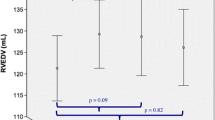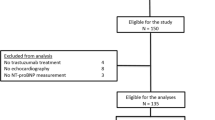Abstract
Little is known about the comparison of multiple-gated acquisition (MUGA) scanning with cardiovascular magnetic resonance (CMR) for serial monitoring of HER2+ breast cancer patients receiving trastuzumab. The association of cardiac biomarkers with CMR left ventricular (LV) function and volume is also not well studied. Our objectives were to compare CMR and MUGA for left ventricular ejection fraction (LVEF) assessment, and to examine the association between changes in brain natriuretic peptide (NT-BNP) and troponin-I and changes in CMR LV function and volume. This prospective longitudinal two-centre cohort study recruited HER2+ breast cancer patients between January 2010 and December 2013. MUGA, CMR, NT-BNP and troponin-I were performed at baseline, 6, 12, and 18 months after trastuzumab initiation. In total, 41 patients (age 51.7 ± 10.8 years) were enrolled. LVEF comparison between MUGA and CMR demonstrated weak agreement (Lin’s correlation coefficient r = 0.46, baseline; r = 0.29, 6 months; r = 0.42, 12 months; r = 0.39, 18 months; all p < 0.05). Bland–Altman plots demonstrated wide LVEF agreement limits (pooled agreement limits 3.0 ± 6.2). Both modalities demonstrated significant LVEF decline at 6 and 12 months from baseline, concomitant with increased LV volumes on CMR. Changes in NT-BNP correlated with changes in LV diastolic volume at 12 and 18 months (p < 0.05), and LV systolic volume at 18 months (p < 0.05). Changes in troponin-I did not correlate with changes in LV function or volume at any timepoint. In conclusion, CMR and MUGA LVEF are not interchangeable, warranting selection and utility of one modality for serial monitoring. CMR is useful due to less radiation exposure and accuracy of LV volume measurements. Changes in NT-BNP correlated with changes in LV volumes.


Similar content being viewed by others
References
Jemal A, Bray F, Center MM et al (2011) Global Cancer Statistics: 2011. CA Cancer J Clin 61:69–90. https://doi.org/10.3322/caac.20107
Slamon DJ, Clark GM, Wong SG et al (1987) Human breast cancer: correlation of relapse and survival with amplification of the HER-2/neu oncogene. Science 235:177–182
Owens MA, Horten BC, Da Silva MM (2004) HER2 amplification ratios by fluorescence in situ hybridiaztion and correlation with immunohistochemistry in a cohort of 6556 breast cancer tissues. Clin Breast Cancer 5:63–69. https://doi.org/10.3816/CBC.2004.n.011
Carter P, Presta L, Gormant CM et al (1992) Humanization of an anti-p185HER2 antibody for human cancer therapy. Proc Natl Acad Sci USA 89:4285–4289
Seshadri R, Firgaira FA, Horsfall DJ et al (1993) Clinical significance of HER-2/neu oncogene amplification in primary breast cancer. J Clin Oncol 11:1936–1942
Vogel C, Cobleigh M, Tripathy D et al (2002) Efficacy and safety of trastuzumab as single agent in first-line treatment of HER2-overexpressing metastatic breast cancer. J Clin Oncol 20:719–726
Hurley J, Coliny P, Reis I et al (2006) Docetaxel, cisplatin, and trastuzumab as primary systemic therapy for human epidermal growth factor receptor 2-positive locally advanced breast cancer. J Clin Oncol 24:1831–1838
Joensuu H, Kellokumpu-Lehtinen P-L, Bono P et al (2006) Adjuvant docetaxel or vinorelbine with or without trastuzumab for breast cancer. N Engl J Med 354:809–820
Piccart-Gebhart MJ, Procter M, Leyland-Jones B et al (2005) Trastuzumab after adjuvant chemotherapy in HER2-positive breast cancer. N Engl J Med 353:1659–1672
Romond EH, Perez EA, Bryant J et al (2005) Trastuzumab plus adjuvant chemotherapy for operable HER2-positive breast cancer. N Engl J Med 353:1673–1684
Marty M, Cognetti F, Maraninchi D et al (2005) Randomized phase II trial of the efficacy and safety of trastuzumab combined with docetaxel in patients with human epidermal growth factor receptor 2-positive metastatic breast cancer administered as first-line treatment: the M77001 study group. J Clin Oncol 23:4265–4274. https://doi.org/10.1200/JCO.2005.04.173
Seidman A, Hudis C, Pierri M et al (2002) Cardiac dysfunction in the trastuzumab clinical trials experience. J Clin Oncol 20:1215–1221
Slamon D, Eiermann W, Robert N et al (2011) Adjuvant trastuzumab in HER2-positive breast cancer. N Engl J Med 365:1273–1283
Perez EA, Rodeheffer R (2004) Clinical cardiac tolerability of trastuzumab. J Clin Oncol 22:322–329. https://doi.org/10.1200/JCO.2004.01.120
Goldhar HA, Yan AT, Ko DT et al (2016) The temporal risk of heart failure associated with adjuvant trastuzumab in breast cancer patients: a population study. J Natl Cancer Inst 108:djv301
Bellenger NG, Burgess MI, Ray SG et al (2000) Comparison of left ventricular ejection fraction and volumes in heart failure by echocardiography, radionuclide ventriculography and cardiovascular magnetic resonance. Are they interchangeable? Eur Heart J 21:1387–1396. https://doi.org/10.1053/euhj.2000.2011
Einstein AJ, Henzlova MJ, Rajagopalan S (2008) Estimating risk of cancer associated with radiation exposure from 64-slice computed tomography coronary angiography. JAMA 298(3):317–323. https://doi.org/10.1001/jama.298.3.317
Einstein AJ, Moser KW, Thompson RC et al (2007) Radiation dose to patients from cardiac diagnostic imaging. Circulation 116:1290–1305. https://doi.org/10.1161/CIRCULATIONAHA.107.688101
Grothues F, Smith GC, Moon JC et al (2002) Comparison of interstudy reproducibility of cardiovascular magnetic resonance with two-dimensional echocardiography in normal subjects and in patients with heart failure or left ventricular hypertrophy. J Am Coll Cardiol 90:29–34
Chung AK, Das SR, Leonard D et al (2006) Women have higher left ventricular ejection fractions than men independent of differences in left ventricular volume. Circulation 113:1597–1604. https://doi.org/10.1161/CIRCULATIONAHA.105.574400
Vasan R, Benjamin E, Larson M et al (2002) Plasma natriuretic peptides for community screening for left ventricular hypertrophy and systolic dysfunction: the Framingham heart study. JAMA 288:1252–1259
Redfield MM, Rodeheffer RJ, Jacobsen SJ et al (2004) Plasma brain natriuretic peptide to detect preclinical ventricular systolic or diastolic dysfunction. Circulation 109:3176–3181. https://doi.org/10.1161/01.CIR.0000130845.38133.8F
Babuin L, Jaffe AS (2005) Troponin: the biomarker of choice for the detection of cardiac injury. CMAJ 173:1191–1202
Kilickap S, Barista I, Akgul E et al (2005) cTnT can be a useful marker for early detection of anthracycline cardiotoxicity. Ann Oncol 16:798–804. https://doi.org/10.1093/annonc/mdi152
Cardinale D, Sandri MT, Martinoni A et al (2000) Left ventricular dysfunction predicted by early Troponin I release after high-dose chemotherapy. J Am Coll Cardiol 36:517–522
Cardinale D, Sandri MT, Colombo A et al (2004) Prognostic value of Troponin I in cardiac risk stratification of cancer patients undergoing high-dose chemotherapy. Circulation 109:2749–2755. https://doi.org/10.1161/01.CIR.0000130926.51766.CC
Barthur A, Brezden-Masley C, Connelly KA et al (2017) Longitudinal assessment of right ventricular structure and function by cardiovascular magnetic resonance in breast cancer patients treated with trastuzumab: a prospective observational study. J Cardiovasc Magn Reson 19:44. https://doi.org/10.1186/s12968-017-0356-4
Mackey JR, Clemons M, Côté MA et al (2008) Cardiac management during adjuvant trastuzumab therapy: recommendations of the Canadian Trastuzumab Working Group. Curr Oncol 15:24–35. https://doi.org/10.3747/co.2008.199
Carstensen B, Simpson J, Gurrin L (2008) Statistical models for assessing agreement in method comparison studies with replicate measurements. Int J Biostat 4:16
Rothman KJ (1990) No adjustments are needed for multiple comparisons. Epidemiology 1:43–46. https://doi.org/10.1097/00001648-199001000-00010
Walker J, Bhullar N, Fallah-rad N et al (2010) Role of three-dimensional echocardiography in breast cancer: comparison with two-dimensional echocardiography, multiple-gated acquisition scans, and cardiac magnetic resonance imaging. J Clin Oncol 28:3429–3436. https://doi.org/10.1200/JCO.2009.26.7294
Fallah-Rad N, Lytwyn M, Fang T et al (2008) Delayed contrast enhancement cardiac magnetic resonance imaging in trastuzumab induced cardiomyopathy. J Cardiovasc Magn Reson. 10:5. https://doi.org/10.1186/1532-429X-10-5
Grover S, DePasquale C, Leong DP et al (2012) Early cardiac changes following anthracycline chemotherapy in breast cancer: a prospective multi-centre study using advanced cardiac imaging and biochemical markers. J Cardiovasc Magn Reson 14(Suppl 1):181. https://doi.org/10.1186/1532-429X-14-S1-P181
Fallah-Rad N, Walker JR, Wassef A et al (2011) The utility of cardiac biomarkers, tissue velocity and strain imaging, and cardiac magnetic resonance imaging in predicting early left ventricular dysfunction in patients with human epidermal growth factor receptor II-positive breast cancer treated with a. J Am Coll Cardiol 57:2263–2270. https://doi.org/10.1016/j.jacc.2010.11.063
Sawaya H, Sebag IA, Plana JC et al (2011) Early detection and prediction of cardiotoxicity in chemotherapy-treated patients. Am J Cardiol 107:1375–1380. https://doi.org/10.1016/j.amjcard.2011.01.006
Drafts BC, Twomley KM, D'Agostino R et al (2014) Low to moderate dose anthracycline-based chemotherapy is associated with early noninvasive imaging evidence of subclinical cardiovascular disease. JACC Cardiovasc Imaging 6(8):877–885. https://doi.org/10.1016/j.jcmg.2012.11.017.Low
Chaosuwannakit N, D'Agostino RJ, Hamilton CA et al (2010) Aortic stiffness increases upon receipt of anthracycline chemotherapy. J Clin Oncol 28:166–172. https://doi.org/10.1200/JCO.2009.23.8527
Acknowledgements
We would like to thank all the study participants who contributed their time to this research study. We also acknowledge the study coordinators for their efforts in data collection. This work was supported by a Canadian Institute of Health Research Industry partnered grant with Hoffman-La Roche Canada Inc.
Funding
This work was supported by a Canadian Institute of Health Research Industry partnered grant with Hoffman-La Roche Canada Inc.
Author information
Authors and Affiliations
Corresponding author
Ethics declarations
Conflict of Interest
C. Brezden-Masley has received research grant support and/or honoraria for educational activities and/or served as consultant to Roche.
Ethical approval
All procedures performed in studies involving human participants were in accordance with the ethical standards of the institutional research committees (St. Michael’s Hospital and Sunnybrook Odette Cancer Centre) and with the 1964 Helsinki declaration and its later amendments or comparable ethical standards.
Informed consent
Informed consent was obtained from all individual participants included in the study.
Rights and permissions
About this article
Cite this article
Dhir, V., Yan, A.T., Nisenbaum, R. et al. Assessment of left ventricular function by CMR versus MUGA scans in breast cancer patients receiving trastuzumab: a prospective observational study. Int J Cardiovasc Imaging 35, 2085–2093 (2019). https://doi.org/10.1007/s10554-019-01648-z
Received:
Accepted:
Published:
Issue Date:
DOI: https://doi.org/10.1007/s10554-019-01648-z




